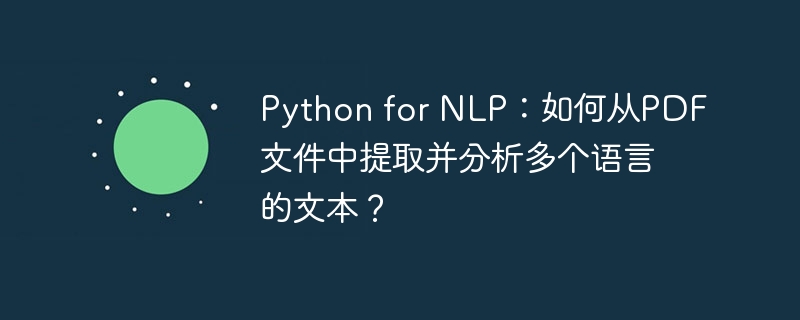

Python for NLP: How to extract and analyze text in multiple languages from PDF files?
Introduction:
Natural Language Processing (NLP) is a discipline that studies how to enable computers to understand and process human language. In today's globalization context, multi-language processing has become an important challenge in the field of NLP. This article will introduce how to use Python to extract and analyze text in multiple languages from PDF files, focusing on various tools and techniques, and providing corresponding code examples.
pyPDF2 library (for manipulating PDF files) is installed, and that the nltk library (for natural language processing) and the googletrans library (for manipulating PDF files) are installed. for multilingual translation). We can install it using the following command: pip install pyPDF2 pip install nltk pip install googletrans==3.1.0a0
pyPDF2 library. Below is a sample code that demonstrates how to extract text from a PDF file: import PyPDF2
def extract_text_from_pdf(file_path):
with open(file_path, 'rb') as file:
pdf_reader = PyPDF2.PdfFileReader(file)
text = ""
num_pages = pdf_reader.numPages
for page_num in range(num_pages):
page = pdf_reader.getPage(page_num)
text += page.extract_text()
return text In the above code, we first open the PDF file in binary mode and then use PyPDF2.PdfFileReader() Create a PDF reader object. Get the number of PDF pages through the numPages attribute, then iterate through each page, use the extract_text() method to extract the text and add it to the result string.
nltk library. Here is a sample code that demonstrates how to detect language in text: import nltk
def detect_language(text):
tokens = nltk.word_tokenize(text)
text_lang = nltk.Text(tokens).vocab().keys()
language = nltk.detect(find_languages(text_lang)[0])[0]
return language In the above code, we first tokenize the text using nltk.word_tokenize() and then use nltk.Text()Convert the word segmentation list into an NLTK text object. Get the different words that appear in the text through the vocab().keys() method, and then use the detect() function to detect the language.
googletrans library to translate it. Here is a sample code that demonstrates how to translate text from one language to another: from googletrans import Translator
def translate_text(text, source_language, target_language):
translator = Translator()
translation = translator.translate(text, src=source_language, dest=target_language)
return translation.text In the above code, we first create a Translator object, Then use the translate() method to translate, specifying the source language and target language.
import PyPDF2
import nltk
from googletrans import Translator
def extract_text_from_pdf(file_path):
with open(file_path, 'rb') as file:
pdf_reader = PyPDF2.PdfFileReader(file)
text = ""
num_pages = pdf_reader.numPages
for page_num in range(num_pages):
page = pdf_reader.getPage(page_num)
text += page.extract_text()
return text
def detect_language(text):
tokens = nltk.word_tokenize(text)
text_lang = nltk.Text(tokens).vocab().keys()
language = nltk.detect(find_languages(text_lang)[0])[0]
return language
def translate_text(text, source_language, target_language):
translator = Translator()
translation = translator.translate(text, src=source_language, dest=target_language)
return translation.text
# 定义PDF文件路径
pdf_path = "example.pdf"
# 提取文本
text = extract_text_from_pdf(pdf_path)
# 检测语言
language = detect_language(text)
print("源语言:", language)
# 翻译文本
translated_text = translate_text(text, source_language=language, target_language="en")
print("翻译后文本:", translated_text)In the above code, we first define a PDF file path, then extract the text, then detect the language of the text and translate it into English.
Conclusion:
By using Python and corresponding libraries, we can easily extract and analyze text in multiple languages from PDF files. This article describes how to extract text, perform multilingual detection, and multilingual translation, and provides corresponding code examples. Hope it helps with your natural language processing project!
The above is the detailed content of Python for NLP: How to extract and analyze text in multiple languages from a PDF file?. For more information, please follow other related articles on the PHP Chinese website!




